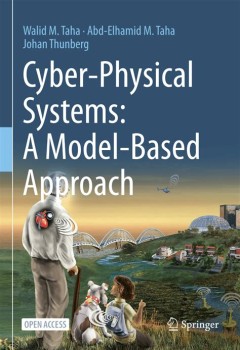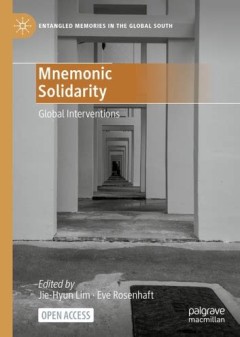Filter by

Annals of Scientific Society for Assembly, Handling and Industrial Robotics
This Open Access proceedings present a good overview of the current research landscape of industrial robots. The objective of MHI Colloquium is a successful networking at academic and management level. Thereby the colloquium is focussing on a high level academic exchange to distribute the obtained research results, determine synergetic effects and trends, connect the actors personally and in c…
- Edition
- 1
- ISBN/ISSN
- 9783662617557
- Collation
- VII, 344 ill; lamp
- Series Title
- -
- Call Number
- -

Mathematical Modeling of the Human Brain
This open access book bridges common tools in medical imaging and neuroscience with the numerical solution of brain modelling PDEs. The connection between these areas is established through the use of two existing tools, FreeSurfer and FEniCS, and one novel tool, the SVM-Tk, developed for this book. The reader will learn the basics of magnetic resonance imaging and quickly proceed to generating…
- Edition
- 1
- ISBN/ISSN
- 978-3-030-95136-8
- Collation
- -
- Series Title
- Simula SpringerBriefs on Computing
- Call Number
- -

The Philosophy of Leopold Blaustein: Descriptive Psychology, Phenomenology, a…
Ini adalah buku akses terbuka yang didedikasikan untuk menemukan kembali sejarah awal fenomenologi dalam konfrontasi dengan warisan Franz Brentano dengan membahas filosofi Leopold Blaustein. Buku ini menawarkan perspektif unik tentang sejarah gerakan fenomenologis dengan mempresentasikan perkembangan teori Blaustein. Blaustein adalah seorang filsuf yang dididik oleh Kazimierz Twardowski di Lvov…
- Edition
- 1
- ISBN/ISSN
- 978-3-031-63685-1
- Collation
- online resource ( IX, 325 Pages)
- Series Title
- Sumber-sumber Utama dalam Fenomenologi; Fenomenologi Awal
- Call Number
- 190 PLO p

Cyber-Physical Systems: A Model-Based Approach
In this concise yet comprehensive Open Access textbook, future inventors are introduced to the key concepts of Cyber-Physical Systems (CPS). Using modeling as a way to develop deeper understanding of the computational and physical components of these systems, one can express new designs in a way that facilitates their simulation, visualization, and analysis. Concepts are introduced in a cross-d…
- Edition
- 1
- ISBN/ISSN
- 9783030360719
- Collation
- XXIII, 187 hlm; ill., lamp.,
- Series Title
- -
- Call Number
- -

An Invisible Thread: Heresy, Mass Conversions, and the Inquisition in the Kin…
Author: Stefania Pastore In Toledo in 1529, a converso named Pedro de Cazalla declared that the connection between man and God was but a thread and that it should not be mediated by the Church. Hardly an isolated phenomenon, Cazalla’s inner spirituality was a widespread response to the increasing repression of religious dissent enacted by the Inquisition. Forced baptisms of Jews and Muslims…
- Edition
- Volume: 85
- ISBN/ISSN
- 978-90-04-71423-6
- Collation
- -
- Series Title
- -
- Call Number
- -

Tracing Private Conversations in Early Modern Europe : Talking in Everyday Life
This open access book provides a multifold exploration of how people in early modern Europe understood, conducted, and actively used private conversations. From sharing personal matters to discussing delicate secrets, all layers of early modern society had their motives for wanting to keep certain exchanges out of public eyes and ears, and ways of trying to achieve this. Detecting such instance…
- Edition
- -
- ISBN/ISSN
- 978-3-031-46630-4
- Collation
- XX, 350
- Series Title
- -
- Call Number
- -

Mnemonic Solidarity : Global Interventions
This open access book provides a concise introduction to a critical development in memory studies. A global memory formation has emerged since the 1990s, in which memories of traumatic histories in different parts of the world, often articulated in the terms established by Holocaust memory, have become entangled, reconciled, contested, conflicted and negotiated across borders. As historical act…
- Edition
- 1
- ISBN/ISSN
- 9783030576691
- Collation
- XI, 135 hlm; ill., lamp.,
- Series Title
- -
- Call Number
- -

Real-time Linked Dataspaces : Enabling Data Ecosystems for Intelligent Systems
This open access book explores the dataspace paradigm as a best-effort approach to data management within data ecosystems. It establishes the theoretical foundations and principles of real-time linked dataspaces as a data platform for intelligent systems. The book introduces a set of specialized best-effort techniques and models to enable loose administrative proximity and semantic integration …
- Edition
- 1
- ISBN/ISSN
- 9783030296650
- Collation
- XXIII, 325 hlm; ill., lamp.,
- Series Title
- -
- Call Number
- -

Data-Driven Fault Detection and Reasoning for Industrial Monitoring
This open access book assesses the potential of data-driven methods in industrial process monitoring engineering. The process modeling, fault detection, classification, isolation, and reasoning are studied in detail. These methods can be used to improve the safety and reliability of industrial processes. Fault diagnosis, including fault detection and reasoning, has attracted engineers and scien…
- Edition
- -
- ISBN/ISSN
- 9789811680441
- Collation
- -
- Series Title
- -
- Call Number
- -

Supersapientia: Berthold of Moosburg and the Divine Science of the Platonists
This study examines the motivations and doctrinal coherence of the Commentary on the Elements of Theology of Proclus written by Berthold of Moosburg, O.P. († c. 1361/1363). It provides an overview of Berthold’s biography and intellectual contexts, his manuscript remains, and a partial edition of his annotations on Macrobius and Proclus. Through a close analysis of the three prefaces to the …
- Edition
- Volume: 1
- ISBN/ISSN
- 978-90-04-46548-0
- Collation
- -
- Series Title
- -
- Call Number
- -
 Computer Science, Information & General Works
Computer Science, Information & General Works  Philosophy & Psychology
Philosophy & Psychology  Religion
Religion  Social Sciences
Social Sciences  Language
Language  Pure Science
Pure Science  Applied Sciences
Applied Sciences  Art & Recreation
Art & Recreation  Literature
Literature  History & Geography
History & Geography